The hot and humid climate of Florida, combined with its thick and lush vegetation, make this state a paradise for snakes. Florida is home to 46 different species of snakes, each of which is vital to balancing the ecosystem. Six of Florida’s snake species are venomous, including three rattlesnakes.

Although there is no region of Florida without one of these rattlesnakes, they are not overly aggressive and typically avoid people and populated areas as much as possible. Let’s look a closer look at the three types of rattlesnakes in Florida.
1. Eastern Diamondback Rattlesnake

The large size and toxic venom of eastern diamondback rattlesnakes make them extremely dangerous.
©Chase D’animulls/Shutterstock.com
| Eastern Diamondback Rattlesnake | Detail |
|---|---|
| Range | All of Florida & some areas of the Florida Keys |
| Length | 33-72 inches |
The eastern diamondback rattlesnake lives all throughout Florida, as well as in some areas of the Florida Keys. This snake is often found in a variety of Florida’s dry habitat regions, such as sand pine scrub areas, pine flatwoods, and even on golf courses. The eastern diamondback rattlesnake is the largest venomous snake in Florida, growing 33-72 inches in length with a very large, heavy body and rough keeled scales. This snake has bold, distinctly marked patterns along its back in the shape of dark diamonds with brown centers and cream borders. While it looks very similar to the western diamondback rattlesnake, the eastern diamondback rattlesnake’s coloring is darker. This snake also has a very large, broad head, with a lightly bordered dark stripe running through each eye to the back of its mouth.
The large size and toxic venom of eastern diamondback rattlesnakes make them extremely dangerous. However, they are not very aggressive. Bites from this rattlesnake typically occur because the snake was intentionally harassed, or because someone accidentally stepped on it. Eastern diamondback rattlesnakes in Florida eat rats and birds, although rabbits seem to be their favorite meal.
2. Dusky Pygmy Rattlesnake
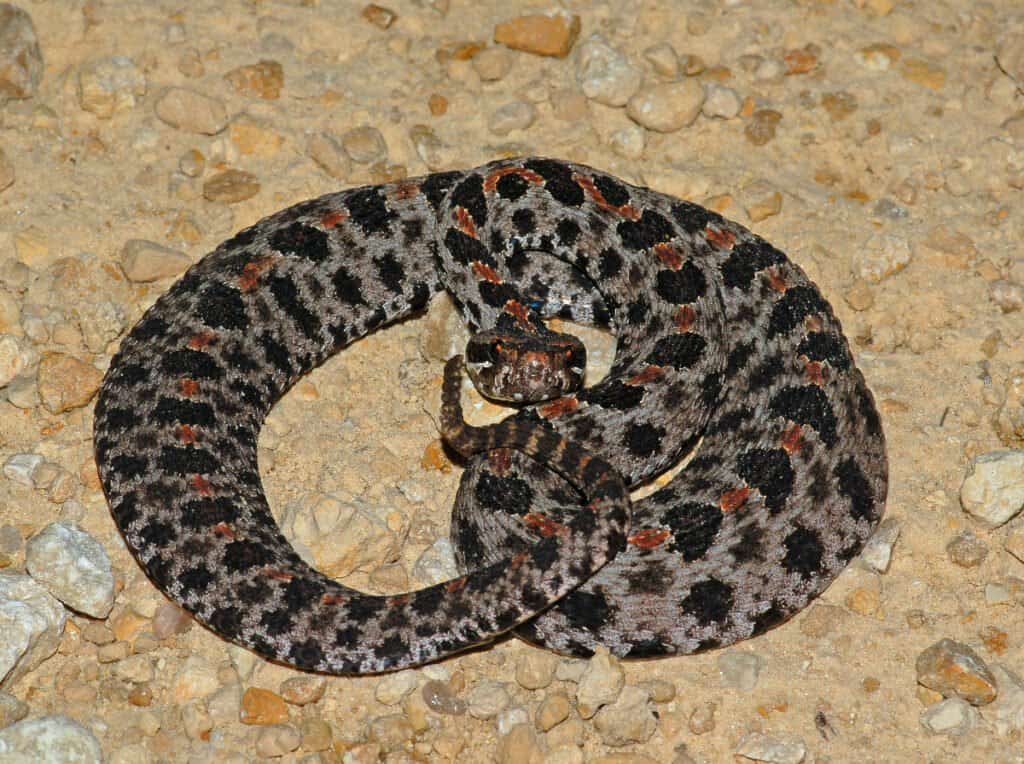
The dusky pygmy rattlesnake has hemotoxic venom.
©Gerald A. DeBoer/Shutterstock.com
| Dusky Pygmy Rattlesnake | Detail |
|---|---|
| Range | All of Florida (except for the Florida Keys) |
| Length | 12-24 inches |
The dusky pygmy rattlesnake is a subspecies of the pygmy rattlesnake and lives all throughout Florida, except for in the Florida Keys. It has also been found on some of the barrier islands, like St. Vincent Island just off Franklin County. Of all the venomous snakes in Florida, the pygmy rattlesnake is encountered most frequently. This snake prefers to live in floodplains and wooded areas like palm hammock habitats, open pinelands, oak scrub, and pine flatwoods. It is also commonly found along the borders of ponds, lakes, cypress swamps, and freshwater marshes.
Dusky pygmy rattlesnakes are the smallest of the venomous snakes in Florida, growing between 12-24 inches in length. They also have very small rattles that are hard to hear. Despite its small size, the dusky pygmy rattlesnake is a bold snake that will often stand its ground. This snake has less venom per bite than the other rattlesnakes in Florida. However, it can still be quite lethal to children and pets. Its hemotoxic venom damages the circulatory system and muscle tissue and causes swelling, hemorrhage, and necrosis.
These snakes are silver or gray with round dark blotches running along the middle of their backs. Many pygmy rattlesnakes also have a red-brown stripe running through or between these dark blotches. Juvenile dusky pygmies look like the adults, except that they have bright yellow tails. Juvenile black racer snakes are often confused for dusky pygmy rattlesnakes, since they are also gray with reddish-brown markings along their backs. Black racers also rattle the tips of their tails when threatened, making a buzzing sound when they are on leaf litter. However, black racers are tiny and very thin with small heads, large eyes, and of course, no rattle.
3. Timber Rattlesnake (or Canebrake)

These snakes are sometimes called “canebrake rattlesnakes” when they live in sugar cane thickets.
©Frode Jacobsen/Shutterstock.com
| Timber Rattlesnake | Detail |
|---|---|
| Range | Northern Florida & limited regions of the Panhandle |
| Length | 36-60 inches |
The timber rattlesnake (or canebrake rattlesnake) only lives in twelve counties in northern Florida and in limited regions of the Panhandle. This snake does not like the hot climates in the rest of the state, so it does not travel much farther south than Gainesville in Florida. Timber rattlesnakes are often found in moist habitats and rough wooded areas. They prefer areas like riverbeds, damp bottomlands, swamps, pine flatwoods, and cane thickets.
Timber rattlesnakes are 36-60 inches long, with large, heavy bodies. These snakes are gray or brown, with distinct, dark chevron or “V”-shaped bands, a reddish-colored stripe down the middle of their backs, and a black tail. The venom of timber rattlesnakes makes them extremely dangerous. However, they only strike as a last resort, and will first try to slither away or rattle their tails in warning.
Other Snakes in Florida
There are 40 other nonvenomous snakes living in Florida in addition to these three rattlesnakes. Although these snakes are not toxic, you should be cautious and leave these snakes alone. Even without venom, they can deliver very painful bites. Additionally, it is illegal to kill any nonvenomous snake in Florida. Here are just a few examples of the many nonvenomous snakes living in Florida.
Southern Water Snake
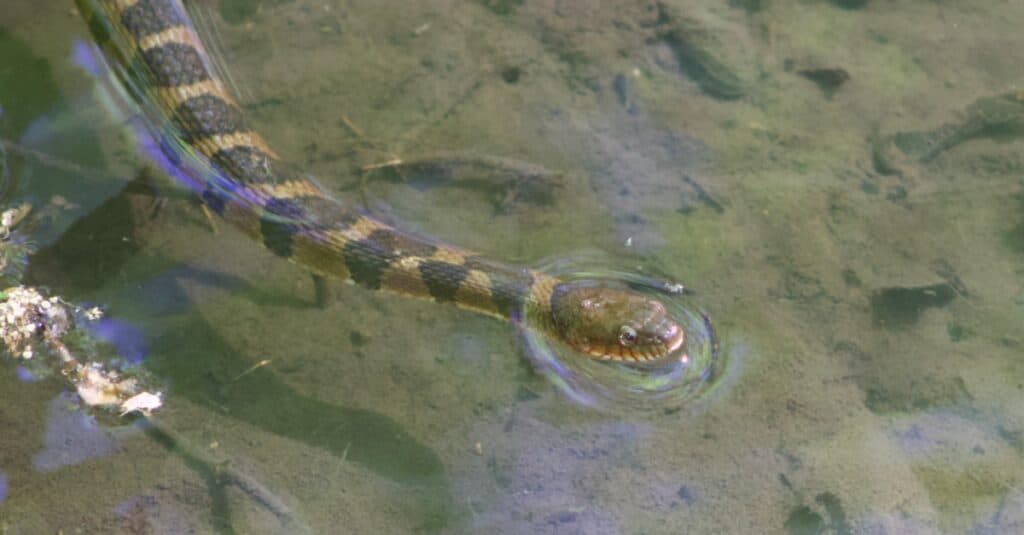
The southern water snake (or banded water snake) can reach a maximum of 5 feet in length.
©iStock.com/Dalene Capps
| Southern Water Snake | Detail |
|---|---|
| Range | Mainland Florida |
| Length | 22-42 inches |
The southern water snake (or banded water snake) lives in every county of mainland Florida. This snake is 22-42 inches long with a thickset body. Large red, brown, or black crossbands run along its body, with thinner, light-colored bands of red, tan, yellow, or gray. As southern water snakes get older, their colors can get darker and can make them look almost entirely black. They have a dark stripe along the sides of their face, running from each eye to the jaw. Like their name, southern water snakes live near bodies of water like ponds, marshes, swamps, canals, and ditches.
North American Racer
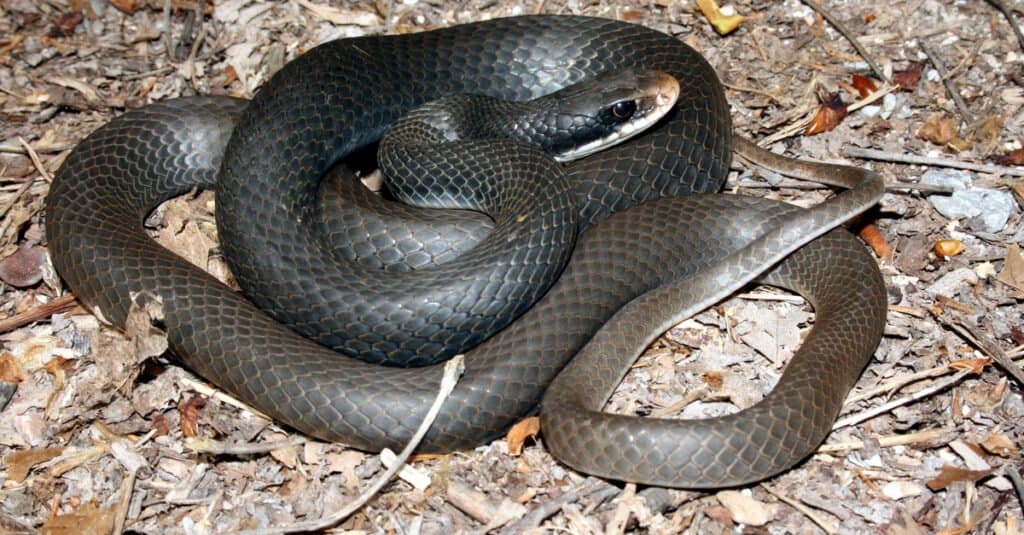
The diet of the North American racer consists of mice, birds, baby rodents, bird eggs, and tree frogs.
©Psychotic Nature/Shutterstock.com
| North American Racer | Detail |
|---|---|
| Range | All of Florida & Florida Keys |
| Length | 20-56 inches |
The North American racer lives in every county of mainland Florida, as well as in the Florida Keys. This snake is long and slender, measuring 20-56 inches in length. The North American racer is sometimes called a “black racer” because of its black or bluish-black coloring. It also has whitish markings on its throat and bellow its face. Juvenile snakes, however, are gray in color, with red-brown blotches along their backs. North American racers are not aggressive, but if they are harassed, they will bite.
Eastern Coachwhip
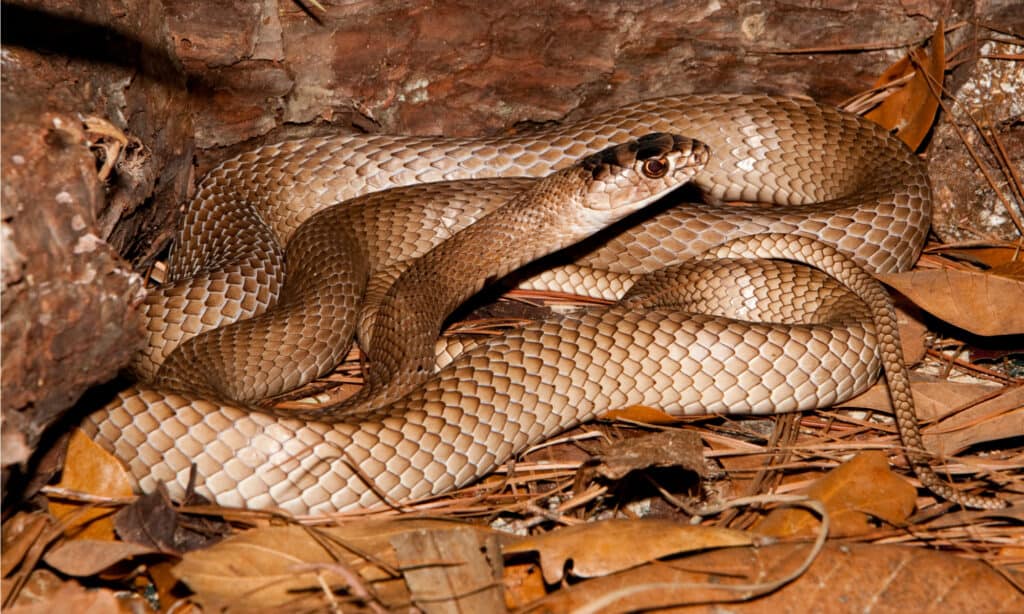
The longest recorded eastern coachwhip snake was 102 inches long.
©Jay Ondreicka/Shutterstock.com
| Eastern Coachwhip Snake | Detail |
|---|---|
| Range | All of Florida |
| Length | Up to 6 feet |
The eastern coachwhip snake lives in every county of Florida. However, this snake is not found much in the wetlands south of Lake Okeechobee, or in the Florida Keys. It prefers dry, hot areas, and is often found along beaches, as well as in palmetto and pine flatwoods, scrub, and longleaf pine-turkey oak sandhills.
Eastern coachwhips are 42-60 inches long and can grow to 6 feet in some exceptional cases. With thin bodies and large eyes, their heads and necks are black or dark brown in color. Further down on the snake this dark color transitions into a light tan color for the remainder of the snake’s body. Juvenile snakes have dark bands and markings on their necks and near their faces. Eastern coachwhip snakes are nonaggressive but will readily bite if grabbed or picked up. These snakes mainly eat lizards in Florida, although on occasion they will also eat small mammals, turtles, snakes, frogs, insects, and birds.
Red Corn Snake
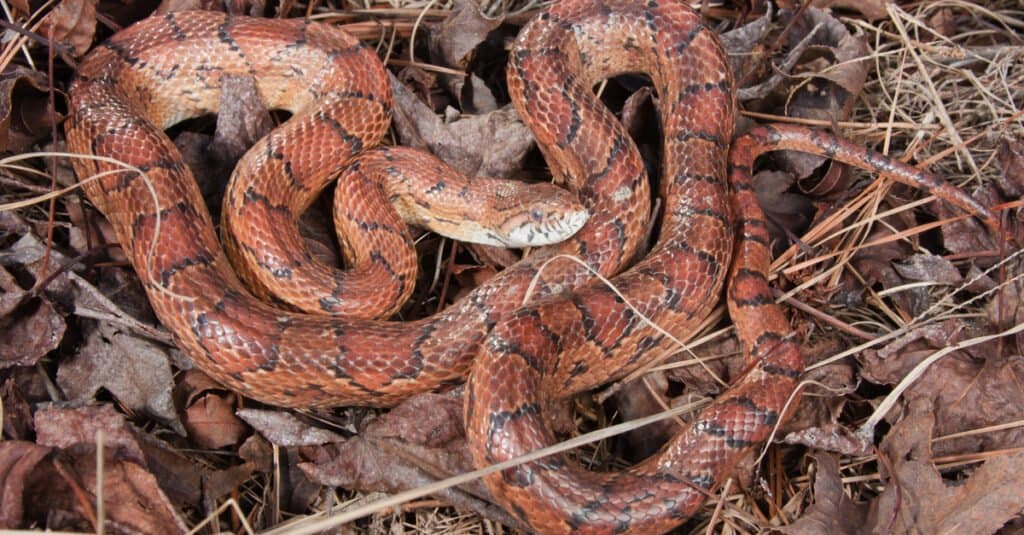
When they rattle their tails in leaf litter, red corn snakes sound like rattlesnakes.
©Nathan A Shepard/Shutterstock.com
| Red Corn Snake | Detail |
|---|---|
| Range | All of Florida & the Florida Keys |
| Length | 30-48 inches |
The red corn snake lives in every county in Florida and throughout the Florida Keys. Red corn snakes prefer hardwood hammock habitats, pinelands, agricultural fields, and swamps. These snakes grow between 30-48 inches in length with orange or orangish-brown colored bodies. They have brown, red, or orange blotches along their backs with black borders. There is also a spear-shaped marking on the snake’s head and neck. Juvenile red corn snakes have a similar appearance to the adults, but usually with more brown coloring. Red corn snakes are also sometimes called “red ratsnakes.”
Summary of 3 Types of Rattlesnakes in Florida
| Type | Range | Length |
|---|---|---|
| Eastern Diamondback | All of Florida and some areas of the Florida Keys | 33-72 inches |
| Dusty Pygmy | All of Florida except for the Florida Keys | 12-24 inches |
| Timber | Northern Florida and limited regions of the Panhandle | 36-60 inches |
The photo featured at the top of this post is © iStock.com/NajaShots
Discover the "Monster" Snake 5X Bigger than an Anaconda
Every day A-Z Animals sends out some of the most incredible facts in the world from our free newsletter. Want to discover the 10 most beautiful snakes in the world, a "snake island" where you're never more than 3 feet from danger, or a "monster" snake 5X larger than an anaconda? Then sign up right now and you'll start receiving our daily newsletter absolutely free.
Thank you for reading! Have some feedback for us? Contact the AZ Animals editorial team.






